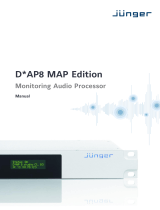Page is loading ...



XAP_manual_EN_170330.doc
X*AP RM
1
Hardware features
•
1RU remote panel detachable panel with case
• Rotary encoder high resolution encoder for parameter settings, volume control
(turn&push) etc. with push function, e.g. for confirmation of settings
• 8 Function Keys F-Keys - function assigned by the application
Hot-Keys – function assigned by the user
• MENU button for menu control
• ESC button for menu navigation
• PAGE button may swap displays
• METER control button selection of the display of the LED bar graphs
• BYPASS button initiates a bypass function of the attached base unit
• OLED display graphical display
• 8 LED bar graphs 16 segment multicolor bar graph display
• Status LED shows the device summary status provided by the attached device
• Power 1/2 LED status of the two power supplies of a attached base unit
• BYPASS LED shows the active bypass status of the attached base unit
• RJ45 connector RJ45 rear connector for Ethernet network connection
• USB-B connector built in USB < > serial adapter to access the service port
Software features
•
Web server http connection with the device for setup and firmware update
•
EmBER plus protocol communication layer for connection with a base unit or 3
rd
party
applications
operating manual

X*AP RM
1
1
Content
page
Introduction …………………………………………………………………………………………… 2
Hardware concept .......……………………………………………………………………………… 2
Control concept ……………………………………………………………………………………… 3
Getting started – IP setup in general ……………………………………………………………… 3
Getting started – IP setup of the X*AP RM
1
remote panel ………..…………………………… 3
Getting started – attach a device to a X*AP RM
1
remote panel ………………………………. 4
Getting started – X*AP RM
1
remote panel Menu page 2/3 – firmware display ……………. 4
Getting started – X*AP RM
1
remote panel Menu page 3/3 – reboot, factory default, test .. 4
Browser based set up – firmware update of the X*AP RM
1
remote panel ………………… 6
Getting started – basic X*AP RM
1
remote panel operation ……………………………………. 6
Operating – menu structure of the X*AP RM
1
remote panel …………………………………… 7
Operating – menu structure of the X*AP RM
1
remote panel – principle of operation …….. 7
Operating – menu structure of the X*AP RM
1
remote panel – menu tree …………………… 9
Technical data – X*AP RM
1
remote panel ………………………………………………………. 10
Safety information …………………………………………………………………………………… 11
Warranty ……………………………………………………………………………………………… 11

X*AP RM
1
2
Introduction
At the heart of the X*AP RM
1
works a high power 32bit embedded micro controller.
It runs a web server to initiate firmware updates.
The communication protocol is EmBER+. So any device that speaks this protocol may easily be controlled by
the X*AP RM
1
.
The X*AP RM
1
remote panel functions are for now limited to operating needs rather than setting up a device.
Beside the pre-configured key functions like loudness measurement or speaker control, the 8 Hot-Keys may
be programmed by the administrator as part of the D*AP events system.
Hardware concept
The X*AP RM
1
remote panel is a stand alone unit. In the past it was possible to mount it in front of some
1RU devices but this is no longer the case.
The X*AP RM
1
remote panel is powered by an external 5V wall power supply. The X*AP RM
1
comes with a
cord grip. One can insert one or two plastic snap-in posts and secure the cable:
Important Note! There are older versions of the X*AP RM
1
around which don't have a 5V input.
These models must be powered via POE (power over Ethernet) either from a switch that has POE ports
or from a POE wall power supply.

X*AP RM
1
3
Control concept
The communication between the X*AP RM
1
remote panel, devices, setup and operating tools, is based on
TCP/IP over Ethernet. The X*AP RM
1
speaks natively EmBER plus protocol.
The setup GUI utilizes web technology. The functionality of the web GUI is developed
for Mozilla Firefox > 10 and Google Chrome > 15.
The X*AP RM
1
knows little about the devices it is able to control but after connecting with a specific device it
downloads a description in XML format and builds up the dedicated menu structure.
Getting started – IP setup in general
The X*AP RM
1
remote panel as well as the remote unit (e.g. D*AP4, D*AP8, and their derivates like the V*AP
or M*AP) must have unique IP addresses and the same network mask in order to "talk" to each other as well
as to other devices / PCs within a Local Area Network segment. If the X*AP RM
1
sits in an other network
segment a suitable gateway address is mandatory. The X*AP RM
1
remote panel may (for now) control up to
4 units, one at a time.
The process of installing a X*AP RM
1
into an IP network is as follows:
1. Ask the system service people for a unique IP addresses of the network,
the netmask and the gateway address.
2. Assign the X*AP RM
1
remote panel an IP address, the netmask and, if necessary,
a gateway address.
4. Attach a device to the X*AP RM
1
remote panel.
Important Note: If you are not familiar with setting up devices for IP communication, we highly recommend
consulting your system service or IT department to assist you.
Getting started – IP setup of the X*AP RM
1
remote panel
By pressing the <MENU> button from the main display, you will enter the X*AP RM
1
"Remote Panel Menu" page 1/3 to set up the IP configuration of the X*AP RM
1
remote panel and to
attach up to four devices to this remote panel:
You may press the respective <F-Keys> and a separate window will appear for comfortable
set-up of the respective part of the IP configuration.
Here is an example for the IP address field (first F-Key):
MENU
ESC
Remote Panel Menu
IP Configuration
Address
10.110.56.7
Netmask
16
Gateway
10.110.100.1
Attach To Base Units (ON = Enables Remote Control)
Device 1
ON
Device 2
OFF
Device 3
OFF
Device 4
OFF
1/3
MENU
ESC
Remote Panel Menu :: IP Configuration
Address
. 110 . 56 . 78 SAVE
10

X*AP RM
1
4
You must press one of the respective <F-Keys> and that field will be highlighted as well as the Rotary
Encoder. Now you can change the value by turning the knob. When the setting of all fields is finished,
you must press <SAVE>. The display will return to the initial "Remote panel Menu" page 1/3.
Getting started – attach a device to a X*AP RM
1
remote panel
You must press one of the "Device x" <F-Keys> of the "Remote Panel Menu"
and a different window will open:
Same procedure: Set up the IP address of the device you are about to attach.
You must turn "Show device in selection" to ON in order to reach that device via the initial display later on.
Pressing <SAVE> will return to the "Remote Panel Menu" menu page 1/3.
Getting started – X*AP RM
1
remote panel menu page 2/3
– firmware display
Via the upper right <page> button you reach the other pages of the Remote Panel Menu:
Page 2/3 shows permanent information of firmware versions and the device.
Getting started – X*AP RM
1
remote panel menu page 3/3
– reboot, restore factory default, device test
Page 3/3 is next in the page cycle:
Page three allows you to reboot or restore of factory defaults. It also offers testing the device. X*AP RM
1
remote panel LEDs, buttons and the rotary knob. Pressing the Device Test button opens up further menus to
test the respective items.
MENU
ESC
Remote Panel Menu :: Attach to Base Units
10 . 110 . 83
10
IP address of device 1 Show device
In selection
SAVE
ON
MENU
ESC
Remote Panel Menu
Firmware Info
Version: 31914
Date: Mo 28. Sep. 13:42:26 CEST 2015
Kernel: 31913
Device Info
2/3
Serial Number: 7201100728
HW Revison: 1
MAC Address: 00:50:C2:58:38:32
MENU
ESC
Remote Panel Menu
Reboot / Restore
Reboot
Reboot &
Restore Factory Defaults Device Tests
3/3

X*AP RM
1
5
When you press <Device Tests> you will get the options to check the LEDs (bar graph and status) the
display and the keys:
Pressing <LED & Display> lets you check the bar graph and status LEDs basic colors:
All bar graph and key LEDs must light in the respective color. Pressing the <Display> button will turn on both
display windows in amber color. You will return by pressing the <ESC> button.
Finally you may check the buttons of the X*AP RM
1
by pressing <Keys> in the upper menu:
When you press a key of your choice the name of it will be displayed - in the example above,
the <BYPASS> button. You can also check the rotary encoder by either turning the knob or pressing on it.
If you turn the knob you will see the momentary value generated in linear and ballistic values.
Pressing on the knob will show the name ENTER in the left display.
MENU
ESC
Remote Panel Menu::DeviceTests
LED & Display Keys
MENU
ESC
DeviceTests::LED & Display
Bars: red
Keys: red Display
Bars: green
Keys: yellow
MENU
ESC
DeviceTests::KexyStateDisplay
pressed keys:
BYPASS
turn knob
linear ballistic
0 0

X*AP RM
1
6
Browser based set up – firmware update of the X*AP RM
1
remote panel
You must open a browser and enter the IP address of the X*AP RM
1
remote panel into the URL field:
You must select the respective
file and press:
After finishing the procedure
the X*AP RM
1
remote panel will
reboot and you must manually
reconnect the device you are
about to control.
Getting started – basic X*AP RM
1
remote panel operation
After power up and booting is finished, the X*AP RM
1
remote panel shows the remote units which are
"attached" to it. The display shows the respective device "Name", its IP address and the connect "Status".
Options are "connect", "can't connect" and "unknown device". In case of "connect" you may press one of the
highlighted buttons.
If you press the <F-Key> the X*AP RM
1
remote panel will connect with that unit.
(The above example has just one unit attached for remote control). Now the X*AP RM
1
remote panel will
gather all necessary information from that unit (it may take a few seconds) and open up the main display:
We assume here that the X*AP RM
1
is controlling a TAP.
Because this is the main operating display, the <ESC> button lights red to indicate that the power up
display is directly above the main display. Pressing <ESC> returns you back to the device selection
(power up display).
MENU
ESC
Remote Panel select device to control
„Name“
10.110.1.55
„Status“
MENU
ESC
Hotkey 1 Hotkey 2 Hotkey 3 Hotkey 4 Hotkey 5 Hotkey 6 Hotkey 7 Hotkey 8
Program 1 Program 2
-21.0
LUFS
-21.5
LUFS
EBU
S
out

X*AP RM
1
7
Operating - menu structure of the X*AP RM
1
remote panel
This example assumes that the X*AP RM
1
is attached to a Television Audio Processor T*AP
(other devices will appear differently):
When pressing the <MENU> button, the main operating menu opens up:
The Audio Processor has the following functions available which you can reach via the F-Keys:
#1<Input> #2<Upmix> #3<Equalizer> #4<Spectral Signature>
#5<Dynamics> #6<Level Magic> #7<Output> #8<Monitor>
Operating – menu structure of the X*AP RM
1
remote panel - principle of operation
If you are in a specific parameter menu the display structure may change due to the program configuration of
the T*AP. Below is an example for setting the parameters for the Dynamics (F-Key #5) while the T*AP is in
5.1 + 2 program configuration and operates in ITU mode. In this case you have two parameter sets for the
first program: ALL and LFE (if the LFE is not linked).
Since the Dynamics have two subsections: Expander and Compressor, this menu has two pages,
indicated by the number in the top right hand corner:
You may switch between both pages with the <page> button
<F-Key 1> toggles between the two parameter sets ALL / LFE. The parameter set under control is
highlighted. If for example you now press <F-Key 5>, the Release setting for the LFE will be enabled and the
Rotary Encoder is also illuminated. You may now change the Ratio by turning the knob.
<F-Key 8> toggles between Program 1 (5.1) and Program 2 (1x2).
MENU
ESC
Menu T*AP 10.110.64.128
Audio
Processor EBU R 128
Meter
MENU
ESC
Hotkey 1 Hotkey 2 Hotkey 3 Hotkey 4 Hotkey 5 Hotkey 6 Hotkey 7 Hotkey 8
Program 1 Program 2
-21.0
LUFS
-21.5
LUFS
EBU
S
out
MENU
ESC
Expander On Threshold [dB] Range[dB]
LFE
ALL On -60 10.0
Program 1
On -60 10.0
Release 1/2
4
4

X*AP RM
1
8
Next page shows the Compressor parameters:
Here another example for <EBU Meter>
In this case the <F-Keys> will control the program based loudness measurement process defined by
EBUR128. The display represents the measurements of Integrated- / Short Term- and Momentary-
Loudness as well as the LRA (Loudness Range) [LU] and Max TPL [dBTP],
the Maximum True Peak level.
The measure for the EBU Meter display is [LUFS] (Loudness Units Full Scale) as long as not defined
differently.
For details pls. refer to the EBU-Tech 3341 document.
MENU
ESC
Compressor On Reference Level[dB] Range[dB]
LFE
ALL On -18 8
Program 1
On -18 8
Ratio Processing 2/2
2.0 uni
uni
2.5
MENU
ESC
EBU R128 Integrated LRA Time
[LUFS] [LU] hh:mm:ss
Input -19.3 6.4
Output -23.2 5.8 00:12:15
Short Term Max TPL Momentary
[dBTP] Max
-19.7 -6.6 -12.0
-21.3 -5.0 -16.0
reset max Program 1
pause
reset

X*AP RM
1
9
Operating – menu structure of the X*AP RM
1
remote panel – menu tree
Power Up Display
<MENU> opens X*AP RM
1
remote panel IP setup menu.
<Address> setup
<Netmask> setup
<Gateway> setup
< empty >
Device 1 setup IP & ON / OFF
Device 2 setup IP & ON / OFF
Device 3 setup IP & ON / OFF
Device 4 setup IP & ON / OFF
<ESC> back to power up display
After connecting with a device the Main Display opens up:
Main Display
<ESC> will jump back to power up display
<MENU> opens Operating display:
F-Key #
1 <Empty>
2 <Audio Processor>
1 <Input>
2 <Upmix> [page 1 - 2]
3 <Equalizer> [page 1 – 5]
4 <Spectral Signature>
5 <Dynamics> [page 1 - 2]
6 <Level Magic> [page 1 - 3]
7 <Output>
8 <Monitor> [page 1 - 2]
<ESC> back to Menu
3 <Empty>
4 <EBU Meter>
1 <empty>
2 <empty>
3 <reset>
4 <pause/continue>
5 <empty>
6 <reset max>
7 <empty>
8 <Program_x>
<ESC> back to Menu
5 <empty>
6 <empty>
7 <empty>
8 <empty>
<ESC> back to Main display

X*AP RM
1
10
Technical data – X*AP RM
1
remote panel
• Power supply External 5V wall power supply with approx. 1m cable attached
• Consumption 12 W
• Dimensions 19", 1RU, depth 6 cm
• Environmental operating temperature 0 ºC to 50 ºC
non-operating temperature -20 ºC to 70 ºC
humidity - 90%, non condensing
• Dimensions 19", 1RU, depth 3 cm
and Weight net weight approx. 0.5 kg shipping weight 1.0 kg

X*AP RM
1
11
Safety information
Electrical
Safety classification External power supply – protective insulation / Schutzklasse II
Power connection Isolated 5V wall power supply.
Water protection The device must not be exposed to splash or dripping water.
It is permitted to place a container filled with liquids (e.g. vases)
on top of the device.
Service safety Only qualified personnel should perform service procedures.
Do not service alone Do not perform internal service or adjustments of the device unless another
person capable of rendering first aid and resuscitation is present.
To avoid fire or personal injury
Mounting It must be placed on a flat surface or must be mounted into a 19" rack.
Provide proper If the device has a built in fan, a gap of at least 1cm must be left
Ventilation between the device edge and the steel angle. It is highly recommended to leave
a gap of at least 1RU above and below the device.
Do not operate Do not operate this product with covers or panels removed.
without covers
Do not operate If you suspect that there is damage to this product, have it inspected
with suspected failures by qualified service personnel.
Risk of explosion The device contains a lithium battery. If replaced incorrectly or by a different
or inadequate type of battery, an explosion may occur.
Warranty
Standard Junger Audio one-year warranty on parts and labor.
Specifications are subject to change without notice

Jünger Audio GmbH
Open Source License Terms
2019-03-21
Lizenzinformationen zu Open Source Software
Dieses Produkt bzw. die hier zum Download angebotene Software enthält Software, die von Dritten
stammt, darunter auch Software, die unter die GNU General Public License Version 2 (“GPLv2”) oder
eine oder mehrere der im Folgenden genannten Lizenzen gestellt ist.
Die Software darf gemäß dieser Lizenzbedingungen genutzt werden. Die jeweils gültige Lizenz kann
den Dateien mit dem Sourcecode entnommen werden.
Haftungsausschluss
Die Programme werden OHNE JEDE GEWÄHRLEISTUNG angeboten, insbesondere nicht für die ALL-
GEMEINE BRAUCHBARKEIT ODER VERWENDBARKEIT FÜR EINEN BESTIMMTEN ZWECK. De-
tails finden Sie in den jeweiligen Lizenzen.
Schriftliches Angebot zum Erhalt des Sourcecodes der unter der GPL lizenzierten Software
Wir werden gegen Erstattung der Kosten für den Datenträger und den Versand des Datenträgers auf
Nachfrage jedermann den Sourcecode der unter der GPL lizenzierten Software auf einer CD-ROM oder
einem ähnlichen Datenträger übersenden. Dieses Angebot ist gültig für einen Zeitraum von drei Jahren
ab Versand des Produktes, auf welchem sich die Software befindet und/oder ab dem Download der
Software.
Bitte richten Sie Ihre Anfrage an:
OSS Download
Sie können den Sourcecode der unter einer Open Source Lizenz stehenden Software unter folgendem
Link herunterladen:
1 of 3

Jünger Audio GmbH
Open Source License Terms
2019-03-21
License information for open source software
This product or the software offered for download contains third-party software, including software li-
censed under the GNU General Public License Version 2 ("GPLv2") or one or more of the following
licenses.
The software may be used in accordance with these license terms. The respectively valid license can
be found in the files with the source code.
Disclaimer
The Programs are offered WITHOUT ANY WARRANTY, including but not limited to the GENERAL US-
ABILITY or FITNESS FOR A PARTICULAR PURPOSE. Details can be found in the respective licenses.
Written offer to receive the source code of the GPL licensed software
Upon request, we will send the source code of any software licensed under the GPL on a CD-ROM or
similar medium upon reimbursement of the cost of the disc and the shipment of the disc. This offer is
valid for a period of three years from the date of shipment of the product on which the software is located
and / or from the download of the software.
Please submit your request to:
OSS Download
You can download the source code of the software under an open source license under the following
link:
2 of 3

Jünger Audio GmbH
Open Source License Terms
2019-03-21
License Texts
•Apache License Version 2.0 (Apachev2.0)
•New Berkeley Software Distribution License (BSD)
•GNU General Public License Version 1 (GPLv1)
•GNU General Public License Version 2 (GPLv2)
•GNU General Public License Version 3 (GPLv3)
•GNU Library General Public License Version 2 (LGPLv2)
•GNU Library General Public License Version 2.1 (LGPLv2.1)
•GNU Library General Public License Version 3 (LGPLv3)
•Massachusetts Institute of Technology License (MIT)
•Mozilla Public License Version 1.1 (MPLv1.1)
•Mozilla Public License Version 2.0 (MPLv2.0)
•Further Licenses
3 of 3


SLIM LINE
Headquarters
Jünger Audio GmbH
Sales • Service & Support
Justus-von-Liebig-Str. 7
12489 Berlin, Germany
phone +49 30 677 721 0
fax +49 30 677 721 46
www.jungeraudio.com
Jünger Audio Asia
Junger Audio Pte. Ltd.
Sales • Service & Support
33, Ubi Ave 3, no. 06-62 Vertex
408868 Singapore
phone +65 6509 8171
fax +65 6748 1740
Jünger Audio (China Office)
Junger (Beijing) Technology Ltd.
Sales • Service & Support
Unit 068, 2nd Floor, No. 38 GuangQu Road,
ChaoYang District, 100021 Beijing, China
phone +86 137 0102 6664
Jünger Audio USA
Service & Support
2100 B2 Walsh Ave
Santa Clara, CA 95050-2590, USA
phone +1 408 330 9215
© 2017 Jünger Audio GmbH
All rights reserved. All trademarks are the property of their respective owners. Product specifications are subject to change without notice.
This material is provided for information purposes only; Jünger assumes no liability related to its use
www.facebook.com/jungeraudio www.twitter.com/jungeraudio
/









